|
|
|
Sort Order |
|
|
|
Items / Page
|
|
|
|
|
|
|
| Srl | Item |
| 1 |
ID:
138359
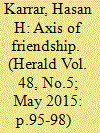

|
|
|
| 2 |
ID:
171128
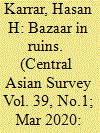

|
|
|
|
|
| Summary/Abstract |
Since 2013, there have been multiple fires in bazaars in Almaty, Kazakhstan. Most of these fires have occurred in Barakholka, the largest bazaar in Central Asia, known for wholesaling in apparel, shoes and low-quality household and office supplies. Ownership of Barakholka is opaque. Using recurrent Barakholka fires as my point of departure, this article contributes to scholarship by describing how the clearing of old bazaars is followed by new property developments and the imposition of new rent regimes. In doing so, I argue that fire – a form of ruination that not only destroys property but also severs networks and people's relationship to a place – is illustrative of how the bazaar, as a new institution within an emerging post-Soviet market economy, was moulded by private interests, and repeated, often ruinous assertions of control over property. I also argue that this process was embedded in a larger political economy that sought to ‘civilize’ the earlier marketplaces. This article is based on ethnographic interviews and repeated visits to the Barakhola between 2016 and 2018, and media accounts of the fires.
|
|
|
|
|
|
|
|
|
|
|
|
|
|
|
|
| 3 |
ID:
179911
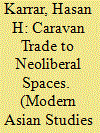

|
|
|
|
|
| Summary/Abstract |
Located along Pakistan's central Asian margins, the high mountain region of Gilgit-Baltistan borders Afghanistan and India, and since 1969 has connected Pakistan to China. In this article, I argue that over the last 50 years, expanding forms of connectivity between Pakistan and China were localized in Gilgit-Baltistan through three processes: (1) from 1969, overland connectivity between Gilgit-Baltistan and western China has enabled Pakistan to imagine and project expansive ties—and geopolitical aspirations—that transcend the border areas where the cross-border trade was initially localized; (2) unfolding ties between the two countries were accompanied by new material exchanges: initially barter trade and regulated caravans, followed by private commerce in the mid-1980s and, finally, economic corridor development under the Belt and Road Initiative; and (3) Chinese investments in Pakistan were part of a new cycle of global accumulation. Concurrently, in the wake of transnational investments, local governance in Gilgit-Baltistan adopted neoliberal administrative measures: the prioritizing of investment capitalism, the privatization of public goods and services, and securitization.
|
|
|
|
|
|
|
|
|
|
|
|
|
|
|
|
| 4 |
ID:
123371


|
|
|
|
|
| Publication |
2013.
|
| Summary/Abstract |
The end of the cold war witnessed the emergence of a commercial web sprawling from the Xinjiang Uighur Autonomous Region in western China and extending into Central Asia (Kazakhstan, Kyrgyzstan, Tajikistan, Turkmenistan, and Uzbekistan), Pakistan, and Russia. Running parallel to the state-managed exchange in hydrocarbons, raw materials, technology, and infrastructure, this new Eurasian trade had an informal component as everyday consumer items manufactured in China were imported into neighboring countries, bypassing formal regulatory mechanisms. This inter-Asian trade began as shuttle trading by itinerant merchants for local markets; by the mid 1990s, shuttle trading was overshadowed by large-scale export for national markets in neighboring countries without losing its informal character. This informality extending across national boundaries defined the post-cold war commerce in innermost Asia; at the same time, it also signaled a return to pre-cold war trading structures. Moving away from the "retreat of the state" thesis that found traction following the cold war, the author attributes informality in this inter-Asian trade to three factors: (1) a restructuring of state power where informal trade was a new comparative advantage sought in an evolving geopolitical climate; (2) the actors in this inter-Asian trade - party and regional officials in China, along with traders and intermediaries - who found and exercised agency through this exchange; and (3) a chain of inter-locking, commercial macro-regions, which are economically sustainable and which transcended international boundaries. Working in conjunction, these factors constitute a dynamic inter-Asian trade and challenge static state imaginaries of a "New Silk Road" or "Eurasian Continental Bridge."
|
|
|
|
|
|
|
|
|
|
|
|
|
|
|
|
| 5 |
ID:
171123


|
|
|
|
|
| Summary/Abstract |
This special issue introduces new research on informal markets and trade in Central Asia and the Caucasus. The research presented here was conducted in Armenia, Georgia, Kazakhstan and Kyrgyzstan, as well as Beijing, Guangzhou, Yiwu and the Xinjiang Uyghur Autonomous Region in China. The following eight articles illustrate how informal markets and trade in Central Asia and the Caucasus provided spaces for people across the region to negotiate state and society in the last three decades; the articles also suggest that informality should be seen as constitutive of a normative order for polities in Central Asia and the Caucasus. Informal markets and trade in Central Asia rest on three factors: the inability of the state to measure commercial transactions; markets and trade becoming places from which citizens built personalized networks that required individualized networking and oral agreements based on social relations, particularly trust; and markets being embedded within states in which clientelism frequently thrives.
|
|
|
|
|
|
|
|
|
|
|
|
|
|
|
|
| 6 |
ID:
160500
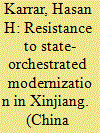

|
|
|
|
|
| Summary/Abstract |
This article seeks to explain periodic unrest in China’s Xinjiang Uyghur Autonomous Region in the years immediately following the Third Plenum. This unrest fractured along ethnic lines between the non-Han and the Han, and in so doing, threatened to unravel Deng Xiaoping’s modernization efforts. Simultaneously, the unrest challenged Beijing’s self-projection as a unitary multiethnic state, and singular Chinese nation. Beijing’s anxiety was evident in its response: memorializing state building on the frontier during the 1940s and 1950s; emphasizing nationalities work; and dispatching veteran revolutionaries to Xinjiang. Foremost amongst them was Wang Zhen (1908–1993), who had led the People’s Liberation Army into Xinjiang in October 1949. During four visits between 1980 and 1982, Wang admonished cadres to love Xinjiang and its people, and to settle contentedly on the frontier. In this article, I argue that in the post-1978 period, unrest in Xinjiang was local resistance to accelerated modernization after the Third Plenum. I also demonstrate how this local resistance to Deng-era modernization led to a deepening of Beijing’s appropriation of the frontier.
|
|
|
|
|
|
|
|
|
|
|
|
|
|
|
|
| 7 |
ID:
147192
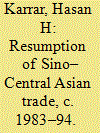

|
|
|
|
|
| Summary/Abstract |
The resumption of trade across the Sino–Central Asian border in 1983 accompanied a gradual thaw in relations between China and the Soviet Union. This paper argues that: (1) Economic liberalization in China (alongside the Soviet Union) created a climate encouraging cross-border exchange. (2) Starting in 1983, improving relations between China and the Soviet Union permitted cross-border exchange in Central Asia; over the subsequent decade, trade volume served as a marker of bilateral relations. (3) Beginning in 1990, efforts by the Chinese leadership to accelerate reform in North-West China, coupled with the independence of Central Asian republics, led to a rapid increase in trade. Hence, the resumption of Sino–Central Asian trade was not grounded in meta-geographical projections – Silk Road, New Silk Road, Silk Road Economic Belt, Eurasian Continental Bridge – but determined by political and economic transitions in the two countries, accompanied by normalizing bilateral relations.
|
|
|
|
|
|
|
|
|
|
|
|
|
|
|
|
|
|
|
|
|